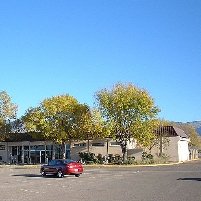Subsidizing a Flight for One Passenger Per Day
Thursday, May 14, 2009
 a busy day at Alamogordo-White Sands Airport
a busy day at Alamogordo-White Sands Airport
When the federal government decided to deregulate the airline industry in the late 1970s, it had to ensure that small town America wasn’t left behind once commercial carriers were given the right to decide where they flew and how much to charge. Thus, the Essential Air Service Program was born, designed to subsidize airlines so they would continue to provide air service to the likes of Show Low, Arizona, Thief River Falls, Minnesota, and other rural areas. The cost of this subsidy program is substantial, about $130 million annually, but it never has been seriously threatened by budget cutbacks, thanks to members of Congress who refuse to let their small-town constituents be stranded without flight service.
The most costly route last year was 200-mile flight between Albuquerque and Alamogordo, New Mexico, which ate up $3,600 per passenger in taxpayer subsidies. For that same amount of money, a family of four could fly from Albuquerque to Paris and back, according to a Bloomberg story that found an average of less than one passenger per day flew to or from Alamogordo in 2008.
While annual subsidies on most routes run between $1 million and $2 million, some companies rely heavily on the federal funding. For instance, Great Lakes Aviation Ltd. got $39 million from the program in 2008, representing 34% of its total revenue.
But even with the subsidies, some small carriers have not been to stay in operation, due to recent spikes in aviation fuel costs. Six carriers, including Phoenix-based Mesa Air Group Inc., have gone out of business or left the program in the past two years
-Noel Brinkerhoff
Small Cities Save Air Links Through Guardian Angels in Congress (by Brian Faler, Bloomberg)
Essential Air Service Program (Office of Aviation Analysis)
- Top Stories
- Unusual News
- Where is the Money Going?
- Controversies
- U.S. and the World
- Appointments and Resignations
- Latest News
- Trump to Stop Deportations If…
- Trump Denounces World Series
- What If China Invaded the United States?
- Donald Trump Has a Mental Health Problem and It Has a Name
- Trump Goes on Renaming Frenzy






Comments